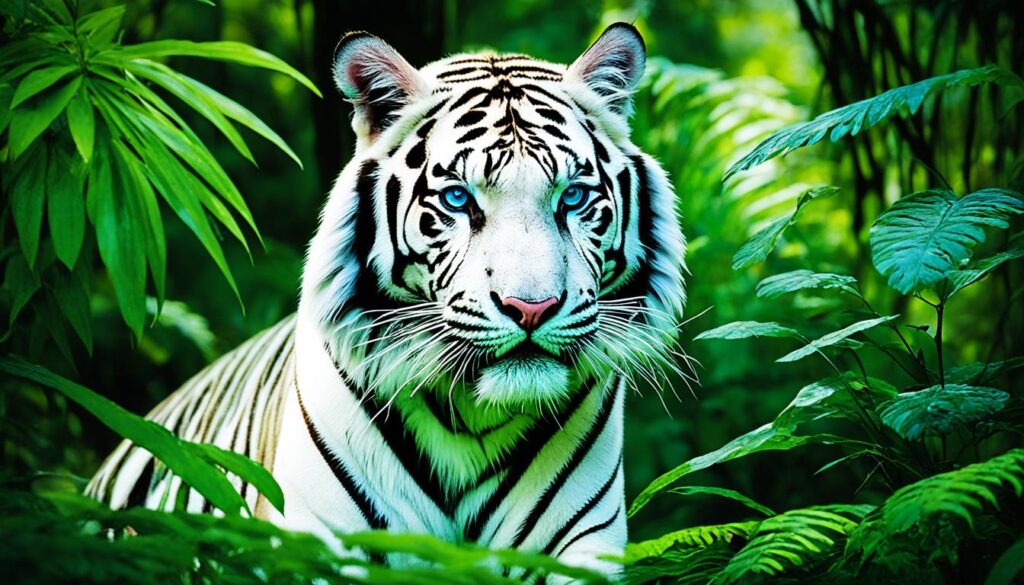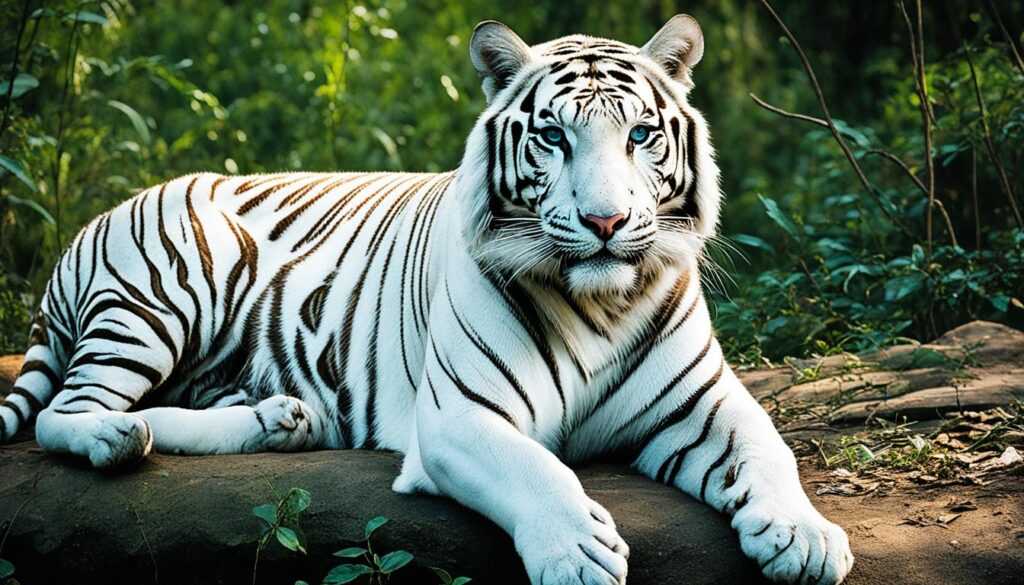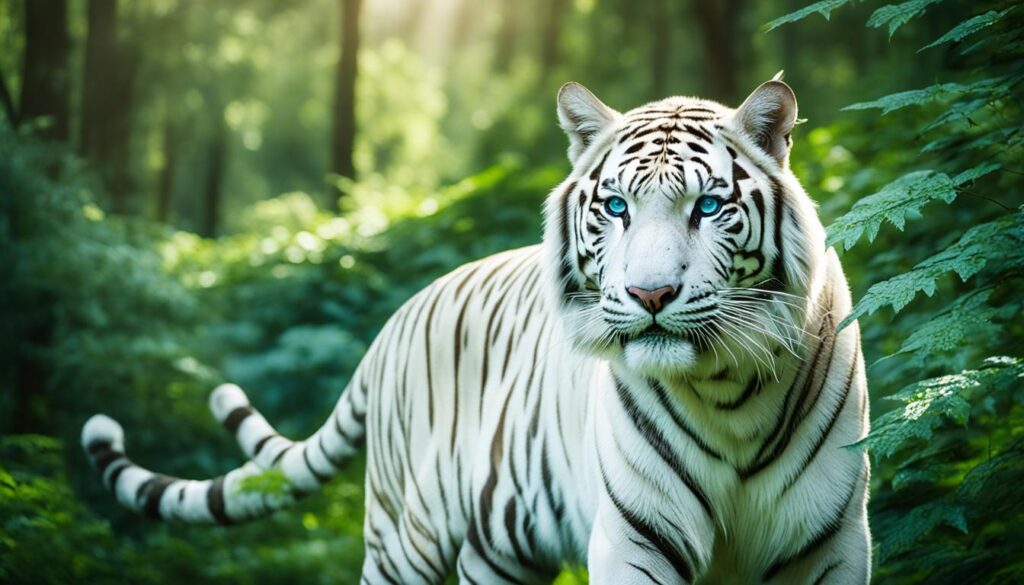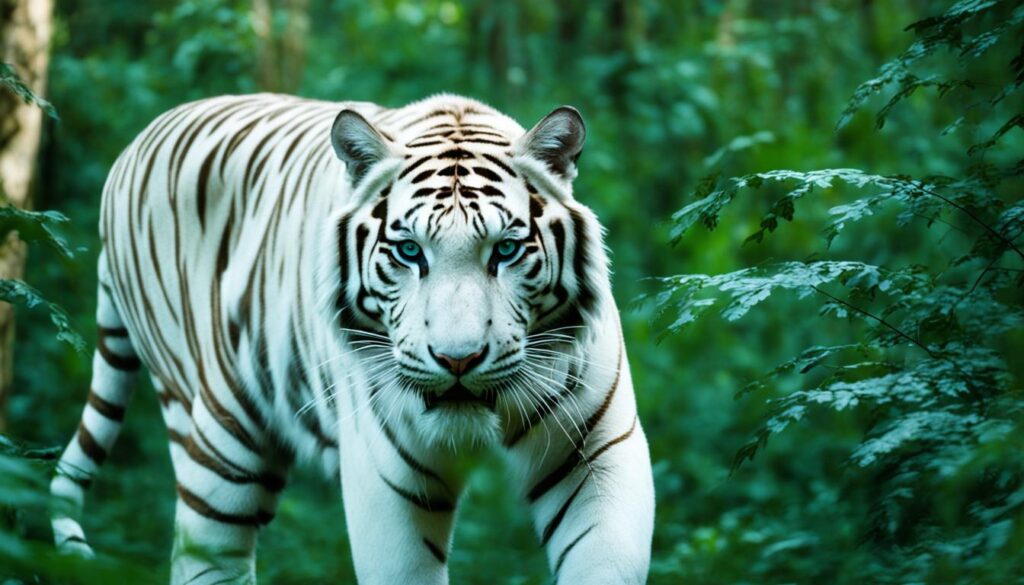Amid the rich tapestry of India’s diverse wildlife, a startling fact emerges: less than 2% of the world’s tiger population are white tigers. These rare animals, shrouded in ethereal beauty and mystique, are not merely colorless shadows of their orange counterparts; they are the gleaming jewels in the crown of wildlife conservation. As the national animal of India, tigers, including the elusive white tiger, command a special reverence and are pivotal to India’s wildlife conservation efforts. To witness the grandeur of the white tiger in India is to embark on a white tiger safari through the carefully preserved tiger reserves of India, where each sighting tells a story of survival and legacy.
Imagine yourself trailing through dense foliage and verdant forests, your senses attuned to the wilderness. The national animal of India could be sunbathing on an ancient ruin or sauntering in the shadows. A mere glimpse on a white tiger safari is an encounter with a living ghost, a rare privilege granted to few. These unique creatures, sublime in their rarity, evoke a profound commitment to wildlife conservation and challenge adventurers to consider their part in safeguarding these majestic beasts within the tiger reserves in India.
Key Takeaways
- White tigers are a breathtaking genetic rarity, making up less than 2% of the global tiger population.
- The importance of the white tiger in India goes beyond its mesmerizing presence—it is central to the nation’s wildlife conservation.
- Experiencing a white tiger safari is both a profound privilege and an opportunity to support wildlife conservation.
- Tiger reserves in India are not just habitats; they are sanctuaries preserving the delicate balance between man and nature.
- India’s dedication to conserving its national animal reflects its cultural commitment to preserving biodiversity.
- Each rare sighting of a white tiger reinforces the urgent need for continued wildlife conservation efforts.
The Mystique of the White Tiger in Indian Culture
Steeped in millennia of history and folklore, the awe-inspiring white tiger stands as a potent symbol within the vibrant tapestry of Indian cultural narratives. The presence of this majestic beast is not merely a natural wonder but resonates deeply as an emblem of mystical strength and spiritual purity. Embarking on a journey through the captivating legacy of the white tiger in Indian culture, we explore the layers of significance that have enshrined this rare animal in the sacred and artistic domains of India.
Significance in Mythology and Folklore
The significance of white tigers is entwined with the mythical tapestry of Indian heritage, where they are often depicted as guardians of ethereal realms or as mounts of deities, signifying a divine status. In the ancient mythological texts, white tigers inspire awe with their celestial association; a phenomenon that enchantingly blurs the lines between the real and the imagined. These stories not only emphasize the tiger’s prowess but also illustrate a reverence that is ingrained in the local consciousness, a reverence that has persisted throughout the corridors of time.
Symbolism of White Tigers in Art and Literature
Traversing beyond the oral traditions, the white tiger’s grandeur and mystique command a significant presence in art and literature. Glimpses of these ethereal creatures adorn the walls of ancient temples, depicted in regal poise and grandeur. In modern narratives, the white tiger continues to be a popular motif, symbolizing a bridge between the historical reverence and contemporary artistic expression. The omnipresence of the creature in various forms of cultural outputs underlines its unceasing influence on the minds and hearts of those who encounter its story.
Captured in myth, celebrated in epic tales, and immortalized in paintings and sculptures, the white tiger advocates a plethora of themes from courage to spiritual enlightenment. Its image not only embeds an aesthetic value in the creative works but also encapsulates the profound mythological references to white tigers that resonate with cultural significance. The narrative of the white tiger is a vivid illustration of how wildlife can imbue culture with rich, symbolic meanings and continue to inspire the canvas of art and the pages of literature for generations.
Through this exploration, one cannot help but appreciate the enduring allure of the white tiger in the cultural heart of India. It is an animal that moves beyond its biological roots and becomes a pivotal strand in the complex web of Indian traditions, beliefs, and artistic expressions—forever an emblem of spiritual and cultural magnitude.
White Tigers: Genetic Marvels of Nature
Beholding the splendor of white tigers can leave you in awe, yet the true wonder lies within their unique genetic traits of white tigers. Unlike albinism, which is marked by a total absence of coloration, white tigers owe their ethereal appearance to a rare genetic variant causing leucism. This condition spares them the color in their eyes while manifesting an absence of pigment in fur, cloaking them in an almost mythical, ghostly white fur, with stripes shadowing their majestic forms.

The presence of leucism in white tigers points to a complex and delicate balance of genetic expressions. Let’s delve into the chromosomal dance that crafts their iconic color—or rather, the lack of it. Such genetic traits of white tigers transform these huge cats into a prismatic anomaly against the lush greens of their habitats, allowing us to glimpse into the rich tapestry that nature weaves.
| Characteristic | Bengal Tiger | White Tiger |
|---|---|---|
| Pigmentation | Rich golden fur with dark stripes | Absence of pigment in fur with pale stripes |
| Genetic Cause | Typical pigmentation genes | Recessive genes causing leucism |
| Eye Color | Usually yellow or amber | Intense blue or emerald green, |
| Rarity | Common variant | Extremely rare |
The allure of white tigers is not merely in their rarity. It is in the story they tell – a tale woven through their DNA and expressed in each quiet step through the forest. As you journey to discover these genetic marvels, remember the fragility of their existence. The rare genetic variant that gifts them such striking beauty also marks them for a life of heightened vulnerability and fascination. So, as you peer into the soulful color in their eyes, you’re not just seeing a white tiger. You’re glimpsing nature’s living artistry, a delicate balance of genes carried through the ages, a marvel of evolution in living, breathing form.
Conservation Crusade: Safeguarding the White Tiger in India
As you marvel at the majestic beauty of the white tiger, it’s important to recognize the tireless efforts behind white tiger conservation. The survival of these iconic creatures relies upon the critical work by organizations such as the National Tiger Conservation Authority (NTCA). Their strategies and advancements in protecting these animals lay the groundwork for a hopeful future.
Protecting a Legacy: The Role of National Tiger Conservation Authority (NTCA)
The NTCA operates with a clear mission: to fortify the safety and expansion of tiger habitats across India. Through their comprehensive approach, white tigers benefit from strengthened legal frameworks, anti-poaching patrols, and a synergy between wildlife management and scientific research. The National Tiger Conservation Authority’s role extends beyond enforcement, seeking to foster a culture where white tiger conservation is a shared responsibility.
Advancements in Anti-Poaching Tactics
Anti-poaching tactics have seen remarkable evolution, primarily driven by technological innovation. Enhanced patrolling schemes now include sophisticated camera traps and aerial drones, which significantly deter illegal poaching activities. These tools also help in collecting crucial data that guides future strategies for the protection of white tigers.
Habitat Preservation and Challenges
Habitat preservation is the cornerstone of ensuring the white tiger’s legacy endures. By protecting and restoring their natural environment, the NTCA helps maintain the balance necessary for their survival. However, with challenges in conservation efforts stemming from human encroachment and climate change, continuous adaptation of our methods is necessary. Concerted efforts towards educating local communities and developing sustainable coexistence plans are paramount.

In recognizing the various challenges in conservation efforts, it’s clear that every step taken towards habitat preservation and the refinement of anti-poaching tactics is indispensable. While the journey is arduous, the goal of a thriving white tiger population in India fuels the ongoing conservation crusade.
India’s Living Museums: Wildlife Sanctuaries and Reserves
As you journey through the vast expanse of India, you’ll find the country is not just rich in culture and history, but also in its dedication to wildlife conservation. The wildlife sanctuaries in India serve as living museums, preserving the majesty of nature and offering safe havens to myriad species, including the illustrious white tiger. Among these sanctuaries, certain destinations stand out for their unique offerings and the chance of rare white tiger sightings.
Pilibhit Tiger Reserve: A Sanctuary for the Striped Stalwarts
The Pilibhit Tiger Reserve remains one of the most impressive bastions for the protection of tigers. Home to a stunning diversity of fauna and flora, it offers you the opportunity to observe these magnificent striped stalwarts in their natural habitat. The reserve is a critical part of wildlife sanctuaries in India, contributing significantly to the conservation of the Bengal tiger.
Ranipur and Amangarh: Lesser-known Havens for the Majestic Cats
While the limelight often shines on India’s more renowned reserves, the smaller sanctuaries like Ranipur and Amangarh are deserving of attention. These lesser-known havens provide tranquility and a vital refuge for a host of wildlife species, including the majestic tigers. Ranipur and Amangarh are gems tucked away from the beaten path, offering intimate glimpses into the lives of these big cats.
Mukundpur White Tiger Safari: A Glimpse into Rarity
The Mukundpur White Tiger Safari is a unique attraction that sets the adrenaline surging for wildlife enthusiasts. Here, you are greeted with the surreal experience of encountering the rare white tiger, a sight to behold and cherish. Encompassing expansive grounds designed to mimic natural habitats, Mukundpur gives visitors a once-in-a-lifetime chance to witness these rare creatures up close.
Exploring these sanctuaries and reserves is an exercise in wonder and respect for the natural world, and whether you are a seasoned wildlife tracker or a curious explorer, the reserves like Pilibhit, Ranipur, Amangarh, and the Mukundpur White Tiger Safari stand ready to reveal their treasures.

Technological Triumphs in Tiger Conservation
In the realm of wildlife preservation, the quest to conserve the majestic tiger has been greatly enhanced by technological advancements in tiger conservation. Pivotal tools such as satellite tracking, DNA analysis, and remote sensing technologies have fostered a new age of efficiency and precision in our approach to protecting these glorious beings and their natural habitats. By employing such innovative methods, conservationists have upped the ante in the battle against extinction, ensuring the tiger’s roar continues to resound through India’s wilderness.

Satellite tracking has proved invaluable in monitoring the movements and health of tiger populations, revealing patterns that help secure their continued survival. DNA analysis provides a window into the genetic diversity and lineage of these creatures, offering insights into their evolutionary journey and aiding in the development of strategic breeding programs. Meanwhile, remote sensing technologies enhance our understanding of forest landscapes, facilitating habitat mapping with impressive accuracy, and enabling real-time monitoring of habitat encroachment and degradation. These tools, together, form a formidable defense against the threats that loom over one of India’s most treasured wildlife species.
| Technology | Function | Benefits |
|---|---|---|
| Satellite Tracking | Monitors real-time location and travel paths of tigers | Enhances response times to potential threats, informs patrolling strategies |
| DNA Analysis | Studies genetic health, relatedness, and diversity among tiger populations | Aids in maintaining genetic diversity and managing breeding programs |
| Remote Sensing Tech | Maps and monitors tiger habitats | Supports habitat conservation by assessing changes and natural resource management |
The corroborative powers of these technological advancements not only empower those on the front lines but also enable each of us to understand and contribute better to the cause of tiger conservation. You have the chance to witness, through these triumphs in technology, a future where tigers and humans live in a more harmonious balance, promoting a thriving ecological system. Indeed, the strategic fusion of technology and naturalism stands as a testament to human ingenuity and our commitment to preserving the world’s precious biodiversity.
Nurturing the Next Generation: Captive Breeding and the Ethical Debate
The quest to preserve the majestic white tiger has led us down diverse paths, one of which is captive breeding. This measure, aimed at boosting population numbers, has been met with a mix of optimism and skepticism. On one hand, success stories in breeding have provided a beacon of hope, demonstrating the potential to sustain genetically viable populations. On the other hand, the ethical debate surrounding captive breeding programs questions the impact of such efforts on the animals’ well-being and the broader goals of wild conservation.
Success Stories and Setbacks
Noteworthy success stories in breeding include numerous zoos and sanctuaries that have reported healthy births of white tiger cubs, contributing to the population’s continuity. However, the path has not been without its challenges of captive breeding, where issues such as genetic defects and lack of genetic diversity have surfaced, raising concerns among conservationists and animal welfare advocates.
Controversy Over Captivity versus Wild Conservation
The controversy over captivity extends well beyond the confines of zoological parks. While some argue that captive breeding is instrumental in educating the public and preserving species that might otherwise face extinction, critics counter-argue that the true essence of conservation lies in wild conservation – protecting habitats and allowing creatures to live autonomously. As we delve into this contention, it becomes clear that a delicate balance must be struck, marrying the necessity for immediate action with the ethical implications of captivity.
| Captive Breeding | Wild Conservation |
|---|---|
| Controlled environments for genetic propagation | Preservation of natural habitats and ecosystems |
| Potential for public education and awareness | Support of biodiversity and natural evolutionary processes |
| Risks of genetic bottleneck and health issues | Challenges of habitat loss and poaching |
| Dependency on human management | Empowerment of wildlife autonomy and integrity |
In conclusion, as you consider the duality of captive breeding and wild conservation, it’s essential to recognize the contributions of both approaches. It is indeed an ethical debate worthy of attention, as each step taken impacts not only the survival of the white tiger but also the preservation of our planet’s precious wildlife heritage.
The White Tiger in India: From Myth to Modernity
Once shrouded in the tapestry of Indian folklore, white tigers have made a remarkable journey from the mystical narratives of old to thriving in India’s rich wilderness today. As living embodiments of history and modernity, the survival stories of white tigers in India not only captivate us with their majesty but also serve as a testament to the complex interplay between local communities and the natural world. With a distinct reverence for white tigers, these communities have transformed their admiration into decisive action, playing a pivotal role in the conservation of this breathtaking species.
Survival Stories: White Tigers in the Wild
Every sighting of a white tiger in the wild is a profound narrative of resilience against daunting odds. These survival stories illuminate the adaptability of white tigers, facing the challenges of nature and human encroachment with remarkable tenacity. Witnessing a white tiger in its natural habitat is to look upon a living legend – a creature that has overcome the brink of extinction to write its own chapter of survival in India’s diverse ecosystems.

From Reverence to Responsibility: The Role of Local Communities
The story of the white tiger is intrinsically tied to the local communities that share its home. Acknowledging the vital role of communities in conservation, we see a shift from mere reverence to proactive responsibility. Villages and towns adjacent to tiger reserves have become custodians of these creatures, understanding that their survival is deeply intertwined with the continuity of their own cultural heritage. It’s a shared journey, where the protection of white tigers stands as a benchmark for broader ecological wellness.
| Community Involvement | Conservation Outcome | Cultural Impact |
|---|---|---|
| Educational Programmes | Informed Protection Efforts | Increased Awareness & Pride |
| Anti-Poaching Activities | Enhanced Tiger Survival Rates | Empowerment & Ownership |
| Sustainable Tourism | Economic Benefits & Habitat Preservation | Respect for Natural Heritage |
| Wildlife Monitoring Efforts | Scientific Understanding & Data Collection | Curiosity & Knowledge Transfer |
As the saga of white tigers in India unfolds, the blend of myth and reality continues to inspire and mobilize people towards preserving this extraordinary animal. By sharing their survival stories, acknowledging the reverence of local communities, and embracing the role of these communities in conservation, the white tiger remains not just a symbol of awe but a beacon of hope for the delicate balance of our natural world.
Photographing the Ghost Stripes: Wildlife Photography in India
India’s rich tapestry of national parks and sanctuaries provide a unique canvas for wildlife photographers captivated by the country’s biodiversity. Renowned for offering an array of photogenic landscapes and wildlife, India has carved out a reputation as one of the premier destinations for wildlife photography. Among the most coveted subjects for camera lenses are the enigmatic white tigers, whose ghostly stripes have fascinated photographers and wildlife enthusiasts alike.

Engaging in wildlife photography in India not only requires patience and skill but also an understanding of the animal’s habitat and behavior. Capturing white tigers in their natural surroundings entails hours of waiting for that perfect shot. Photography tours within national parks and sanctuaries specifically designed for wildlife photographers have become increasingly popular over the years. They offer enthusiasts a chance to learn from seasoned wildlife photographers while ensuring ethical practices are followed during the shoot.
As someone eager to immerse in the world of wildlife photography, you may consider joining planned photography tours that provide a structured and guided approach to capturing the best of India’s wildlife. With expert guidance, you can improve your technique, discover unique vantage points, and share experiences with fellow photographers.
“There is something magical about locking eyes with a white tiger through the lens of a camera. In that moment, you’re not just capturing an image; you’re preserving a moment of wild serenity.”
National parks such as Ranthambore, Bandhavgarh, and Jim Corbett are hotspots for photographers with a longing to document the realm of tigers. Combining the thrill of the safari with the pursuit of the perfect shot, these parks provide access to some of the most awe-inspiring backdrops you can imagine.
Here’s a quick guide highlighting popular national parks for wildlife photography, especially tailored to those with a passion for capturing white tigers:
| National Park | White Tiger Opportunities | Photography Tour Features |
|---|---|---|
| Ranthambore National Park | Sporadic sightings in stunning forest settings | Guided safaris with experienced wildlife photographers |
| Bandhavgarh National Park | High density of tigers for increased chances of sightings | Workshops on wildlife photography amidst ancient ruins |
| Jim Corbett National Park | Diverse habitat increases likelihood of unique photos | Elephant-back photo expeditions for an elevated perspective |
Whether you’re an amateur or a professional, the world of wildlife photographers is always welcoming, brimming with stories of elusive captures and serendipitous encounters. In India, every safari is an opportunity to chronicle the story of conservation, one frame at a time. As you embark on your quest for the perfect image, remember that the essence of wildlife photography is not just about capturing white tigers, but also about echoing their silent plea for preservation through your artistry.
Exploring the White Tiger Trail: Safari Tours in India
Embark on a journey where adventure travel meets the wild majesty of India’s fauna with white tiger safari tours. The thrill of the chase and the beauty of a potential encounter lures visitors from around the world, seeking the ultimate safari experiences. In this guided exploration, you’re not just a spectator; you become a part of the vibrant ecosystem that is the Indian jungle. With expert guides at the helm, guided tours offer exhilarating opportunities to observe these majestic creatures in their natural environment.

For those wondering about the best places to see white tigers, the famous sanctuaries such as Bandhavgarh National Park and Ranthambore National Park are not to be missed. Here, in the dense foliage and under the watchful eyes of wildlife experts, white tigers move with silent grace. Each of these preserves provides a sanctuary for wildlife and an unbeatable experience for any adventurer.
- Spectacular sightings in Bandhavgarh National Park, known for its high density of tigers, including the elusive white tigers.
- Memorable jeep safaris through the vast and rugged terrain of Ranthambore National Park, offering an authentic wildlife encounter.
- Exclusive elephant rides in Kanha National Park provide a unique perspective and an ancient connection to these lands.
Your safari experiences are enhanced with the insights of natives who respect and know these beasts as their neighbors. These moments become more than just photographs—they become invigorating memories etched into the soul of every visitor.
Concluding your day, the setting sun blankets the landscape in a golden hue, a perfect backdrop to reflect on the day’s adventure travel. As night falls, the jungle comes alive with nocturnal whispers, promising that with each white tiger safari tour, the enigma of the jungle deepens, leaving a desire to return to these untouched wilds.
Conclusion:
Throughout our journey delving into the realm of the white tiger in India, we have unearthed their profound significance within the nation’s cultural tapestry and the crucial strides in white tiger conservation efforts. The safeguarding of these regal creatures is more than a commitment to preserving biodiversity; it’s a testament to the enduring legacy of India’s wildlife heritage. Each white tiger is a living embodiment of India’s rich ecological and cultural narratives, a narrative that inspires awe and respect across the globe.
Recognizing the pivotal role that wildlife sanctuaries play, India has become a sanctuary not just for white tigers but for the delicate balance of its entire ecosystem. Safari tours serve as both an educational platform and an immersive experience for you to witness the magnificence of these majestic felines. They are a reminder that our involvement in white tiger conservation can spur positive change and foster ecological balance, ensuring the survival of these mystical animals for generations to come.
Your appreciation for these fascinating creatures should extend beyond the bounds of safari adventures and into the actions that contribute to their survival. Together, we can strike a harmony between development and the natural world, making room for the white tiger to roam free and secure within India’s vast biodiversity. Engage in conversation, spread the word, volunteer, or support organizations dedicated to this cause. Your efforts, no matter how small, help maintain the delicate equilibrium of life that the white tiger represents.
FAQs:
Q: What is the significance of the white tiger in Indian culture?
A: The white tiger holds a deep-rooted mystique in Indian culture and is often associated with divine and supernatural qualities. It features prominently in mythology and folklore, symbolizing power, bravery, and spiritual connection.
Q: Is the white tiger a rare genetic variant?
A: Yes, the white tiger is a rare genetic variant of the Bengal tiger. It is not simply an albino; it possesses a recessive gene called “leucism” that gives it its unique appearance.
Q: What conservation efforts are in place to protect the white tiger in India?
A: The National Tiger Conservation Authority (NTCA) plays a crucial role in safeguarding the white tiger and its habitat. Advancements in anti-poaching tactics and habitat preservation are key components of conservation efforts.
Q: Where can I see white tigers in India?
A: There are several wildlife sanctuaries and reserves in India where you may have the opportunity to witness the majestic presence of white tigers. Pilibhit Tiger Reserve, Ranipur, Amangarh, and Mukundpur White Tiger Safari are examples of such places.
Q: What technological advancements have revolutionized tiger conservation in India?
A: Technological advancements, such as satellite tracking, DNA analysis, and remote sensing technologies, have played a pivotal role in monitoring tiger populations, studying genetic diversity, and mapping habitats.
Q: What is the ethical debate surrounding captive breeding of white tigers?
A: Captive breeding programs for white tigers have sparked an ethical debate. While they have led to successful breeding, there are concerns about the welfare of the animals and the importance of balancing conservation efforts with the preservation of their natural habitat.
Q: Are there white tigers living in the wild in India?
A: Yes, there are white tigers that have adapted to living in the wild in India. These survival stories showcase their resilience and the role of local communities in their protection.
Q: Can I capture images of white tigers through wildlife photography in India?
A: Yes, India offers incredible opportunities for wildlife photography, including capturing the allure of white tigers. Photography tours in national parks and sanctuaries provide the chance to immortalize these magnificent creatures through your lens.
Q: Are there safari tours available to witness white tigers in their natural habitat?
A: Yes, safari tours in India provide an exhilarating experience for those seeking to witness the majesty of white tigers in their natural habitat. Guided tours offer the adventure and excitement of tracking white tigers, whether by jeep safari or elephant ride.
